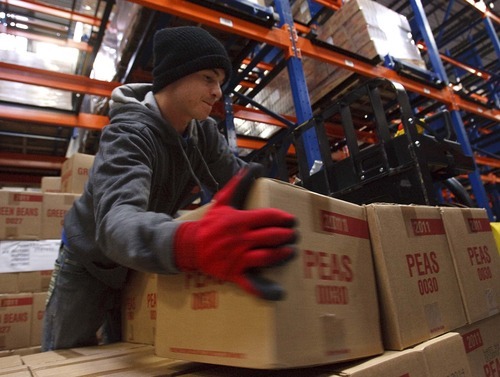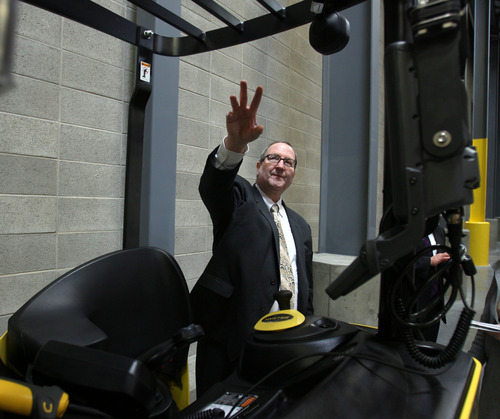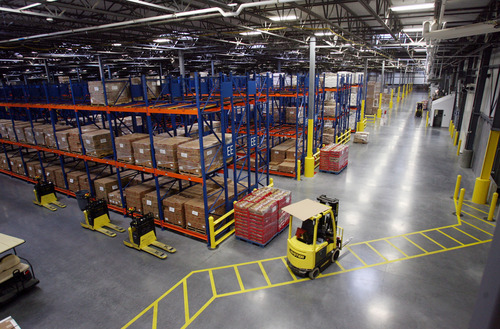This is an archived article that was published on sltrib.com in 2012, and information in the article may be outdated. It is provided only for personal research purposes and may not be reprinted.
At the new Utah Bishops' Central Storehouse, pallets loaded with food wait to be ferried to locales near and far, their destinations handwritten in black marker on plastic wrap covers: Lindon, Ely, Mesa, San Diego, St. George.Richard Humpherys, storehouse manager, stops a golf cart next to one steel storage rack, slits open a cardboard box with a pocket knife and pulls out a can of peaches made with fruit grown at an LDS Church orchard and processed at its cannery in Lindon. The can's label is stamped "The Church of Jesus Christ of Latter-day Saints" and "Welfare Services, Salt Lake City, Utah." This, Humpherys said as he holds the can in his palm, is "the best food money can't buy."The new storehouse, which opened in January, is the centerpiece of the LDS Church's intricate network for taking care of its members and lending a hand to others in times of natural disasters, putting scriptural encouragements into action in the aftermath of hardship, hurricanes, floods, fires and earthquakes across the nation and around the world."As I walk through, I [don't] think, 'What a beautiful building' but how the Lord must truly love the poor to provide this building to take care of their needs," Humpherys said during a tour of the facility, built with members' donations.Since its inception, the LDS Church has viewed looking after its members' well-being as part of its core mission. During the Great Depression, when unemployment ran 30 percent among members, the church formalized its welfare system. It opened the first regional storehouse in 1937 on Pierpont Avenue in Salt Lake City and began to buy orchards, farms and cattle ranches to provide commodities to redistribute to those in need.The church buys many items it keeps on hand today at the storehouse - from wheelchairs to sugar and rice. But the system works much the same way it did at its start: It begins with a call from a Mormon bishop seeking help either for his congregants or his community.It has never been a "dole" system, Humpherys said, which "helps maintain the dignity" of the process. A recipient may be asked, for example, to help clean a church or fix a widow's fence in exchange for aid; a single mom might be asked to "stay home and take good care of her kids."Today, the central storehouse uses its own fleet of trucks to take food and supplies across the country to five regional storehouses, located in Indianapolis; Tucker, Ga.; Lethbridge, Canada; Hermiston, Ore.; and Mira Loma, Calif. From there, the goods fan out to more than 200 local storehouses.But the Salt Lake City storehouse at 5405 W. 300 South is command central, especially in a natural disaster. It can dispatch food, supplies and volunteers anywhere in the United States within 12 hours to 18 hours of a disaster, though it often reacts even quicker - a feat, Humpherys said, that has triggered visits from the Federal Emergency Management Agency, Defense Department and other government agencies wanting to know how the Mormons do it.The answer, he said, is the church's lay leaders who know their community's needs, its supply network and a massive number of volunteers ready for action."There are things they can't duplicate," he said. "On the other hand, there are things we can't do, so we try to work in partnership with the government and other religious groups."Consider the earthquake that struck Haiti on Jan. 12, 2010. By the time LDS leaders in Salt Lake City wrapped up the initial call for help from Haitian bishops, six semis loaded with supplies were already making their way to Miami, where the goods were to be flown by military transport to the devastated country.Or Hurricane Katrina in 2005. The storehouse dispatched semis packed with food and supplies while the storm battered the Gulf Coast. The trucks formed a semi-circle that stretched from Texas to South Carolina, where they waited until the winds and rains abated enough for them to make their way into the worst-hit areas. In all, the LDS Church sent 450 semitrailers of food and supplies and coordinated work of 4,000 volunteers a week.Humpherys acted with similar speed when Hurricane Wilma socked Florida later that year. As the storm stalled over the Yucatan, Humpherys readied four big rigs and put them on the road, telling drivers he would let them know later where they were headed. Meanwhile, he delivered satellite phones to Mormon bishops and told them to call if they needed help.Among the first to phone: a Miami-area bishop who was providing refuge to 200 people in a church building that lacked power, food and other supplies. Humpherys let him know a truck would be able to reach him in 30 minutes."He called back after they'd unloaded," Humpherys recalled, "and said, 'You have no idea how much that meant to our people to see a Deseret Transportation truck there 30 minutes after the storm passed.' "Michael Poulter became bishop of Farmington's 5th Ward four years ago, just as the U.S. entered a severe economic downturn.The number of families and individuals needing help each week in his Davis County congregation doubled to about a dozen at one point, he said. Food was a priority, but he also helped people pay rent, utility bills and work through mortgage problems. In return, he asked recipients to volunteer at Deseret Industries, a church-owned thrift store, one of the faith's canneries and on neighborhood service projects."We're all about helping these families and individuals get back to self-sufficiency and bridge the gap when they are underemployed or become unemployed," Poulter said. "Usually, there is an overwhelming sense of gratitude because things are tough and you are looking for any answers you can find. If you can relieve a little stress, it can change their whole outlook."For disasters outside the U.S., the LDS Church typically sends cash rather than food and supplies, avoiding expensive shipping costs and helping to re-energize local economies while also ensuring people get what they need. That's "rice and beans in South America," Humpherys said, "versus peaches and peanut butter."Each day, storehouse workers walk through a hallway lined with inspirational quotes and photos - a homeless man crumpled on a street curb; former President Ronald Reagan touring the old storehouse in 1983; an 1895 photo of women extracting silk at the church's long-gone sewing center. It's all a daily reminder, Humpherys said, that "we're here to help one another."He drives home that point with this story: During Hurricane Katrina, an older couple from Logan were sent to work at the bishop's storehouse in Slidell, La. The woman called Humpherys one day, upset. Another church group, she complained, was taking canned goods and plastering its own labels over those of the LDS Church.Humpherys asked her: "What's the real issue?"People are hungry, she said. Right, he answered."It doesn't matter what it says on the outside," he told her. "It's what's inside - and inside your heart."brooke@sltrib.com —
Bishops' Central Storehouse by the numbers
3,500,000 • Miles driven by Deseret Transportation drivers
535,966 • Square feet at office and storehouse
65,000 • Pallet capacity
200 • Smaller bishops' storehouses in U.S. and Canada
143 • Types of food and commodities
92 • Employees
50 • Trucks in and out daily
44 • Loading docks
43 • Full-time truck drivers
36 • Acres at storehouse property
7.0 • Magnitude of earthquake designed to withstand
5 • Regions that receive supplies from storehouse

















